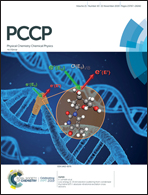Atmospheric chemistry of the self-reaction of HO2 radicals: stepwise mechanism versus one-step process in the presence of (H2O)n (n = 1–3) clusters†
Abstract
The effects of water on radical–radical reactions are of great importance for the elucidation of the atmospheric oxidation process of free radicals. In the present work, the HO2 + HO2 reactions with (H2O)n (n = 1–3) have been investigated using quantum chemical methods and canonical variational transition state theory with small curvature tunneling. We have explored both one-step and stepwise mechanisms, in particular the stepwise mechanism initiated by ring enlargement. The calculated results have revealed that the stepwise mechanism is the dominant one in the HO2 + HO2 reaction that is catalyzed by one water molecule. This is because its pseudo-first-order rate constant (kRWM1′) is 3 orders of magnitude larger than that of the corresponding one-step mechanism. Additionally, the value of kRWM1′ at 298 K has been found to be 4.3 times larger than that of the rate constant of the HO2 + HO2 reaction (kR1) without catalysts, which is in good agreement with the experimental findings. The calculated results also showed that the stepwise mechanism is still dominant in the (H2O)2 catalyzed reaction due to its higher pseudo-first-order rate constant, which is 3 orders of magnitude larger than that of the corresponding one-step mechanism. On the other hand, the one-step process is much faster than the stepwise mechanism by a factor of 105–106 in the (H2O)3 catalyzed reaction. However, the pseudo-first-order rate constants for the (H2O)2 and (H2O)3-catalyzed reactions are lower than that of the H2O-catalyzed reaction by 3–4 orders of magnitude, which indicates that the water monomer is the most efficient one among all the catalysts of (H2O)n (n = 1–3). The present results have provided a definitive example that water and water clusters have important influences on atmospheric reactions.



 Please wait while we load your content...
Please wait while we load your content...